Ipswich, Queensland, Australia, is located in South East Queensland, approximately 40 kilometres (25 miles) west of the Brisbane CBD.
The Jagera Aboriginal People
The Jagera Aboriginal people inhabited the land around Ipswich and many Aboriginal sites can be found in this area of South East Queensland.
There are 200 Bora (ceremonial rings)
sites recorded, significant cave etchings and paintings, scarred trees, fish traps, burial sites, Aboriginal quarries, grinding grooves, hearth sites, multiple dreaming sites, deity sites and storylines, dispute rings, massacre sites, old mission sites, camping sites and large concentrated areas of stone tools within manufacturing sites.
jageradaran.com.au).
Also, interestingly, the Australian English word "yakka'" (often meaning 'work', as in 'hard yakka') came from the Jagera language (yaga, "strenuous work").
Full text of
"Tom Petrie's reminiscences of early Queensland (dating from 1837)"
 |
| Aboriginal Mystic Bora Ceremony, ca. 1900-1927 |
Finding Limestone Hill: 1824
John Oxley, Allan Cunningham and Lieutenant Butler noticed the mouth of the Bremer River while on their way in a rowboat from Redcliffe
to explore the Brisbane River in September 1824, where a convict settlement had been established.
Oxley wrote in his diary how they had seen a "considerable creek or stream" branching off the Brisbane River. On the way back from
their exploration a short time later, Oxley and his companions decided to camp near the creek they had seen; and Oxley referred to it as the Bremer River, named in honour of the British naval officer, Admiral Sir John Bremer.
The three explorers also saw a group of Aboriginal people eating "long worms", which they had found in some rotting timber. The family ran away upon seeing the explorers, and so the explorers examined the
belongings of the Aboriginal people: stone hatchets, spears and baskets, but took nothing as they wished to show their "good intentions towards them".
It was not until 1827 that Captain Logan, the Commandant of Brisbane, explored the locality now called Ipswich.
Logan first sent an overseer and five convicts to the place he called Limestone Hills, now Ipswich, to quarry Limestone, which was burnt at the quarries and sent down to Brisbane by the river. Buildings such as the old Brisbane Treasury, then used as military barracks, were built from this stone. Logan also
established agriculture on land now occupied by the Ipswich Racecourse, growing maize, oats, and potatoes.
 |
| Captain Patrick Logan (1791 – 1830) |
Convicts at Limestone Hill
The convicts had a hard time at Limestone Hill, as the Aboriginal people, wanting to drive them out, stole
their tools. So Logan ordered soldiers to be stationed at the new settlement to protect the quarry works, which would later produce up to 400 baskets of lime each week.
The trip to get to Limestone from the Morton Bay settlement (Brisbane) took 11 hours by boat.
Allan Cunningham then visited Ipswich for five days in August 1828, with convict servants and two bullocks. He camped under a fig tree, now known as Cunningham’s Knoll on Queen Victoria Parade and went on to
discover a pass through the Great Dividing Range, named Cunningham’s Gap, which allowed access from Brisbane and Moreton Bay and the Darling Downs. However, it would be another twelve years until there would be settlers on the Darling Downs.
As the Queensland colony grew, there was a greater need for food, and so, Logan sent sheep to Limestone Station, where a sheep and cattle station was established on Bamdamba Creek. Later, a farm called Plough Station (a suburb of Raceview) operated in the area, within Cascade Street, Riverview Street and Roberton Road.
The first brick cottage
was built in 1829. The earliest water came from a natural spring in the Old Pump Yard (now RSL Memorial Hall).
The First Park In Queensland: 1840s In the first survey of Limestone in 1842, Henry Wade set aside a "reserve for public recreation and botanic gardens" at Woodend of 80 acres. This was the first park to be developed in Queensland. On these original plans, above the words, "Proposed Plan of the Town of Limestone, by Henry Wade Surveyor", added in smaller writing, "to be called IPSWICH".
Governor Gipps, however, decided that Wade had made the plan for the streets too narrow and that a town square was not needed. He also decided to change
the name of the settlement from Limestone to Ipswich. Perhaps, because Ipswich in England was at one time spelt, "Gippeswic", which is very similar to Gipps own name.
Travelling To Ipswich
The best way to get to Ipswich from Brisbane was by the river, but it was an arduous and time-consuming process. The botanist named Fraser, who once
travelled with Captain Logan to Ipswich, said that the trip took 11 hours on the way up and 13 hours on the return trip. In the early days, punts, which were flat-bottomed boats, were used to carry people and the quarried limestone.
In 1843 Governor Gipps changed the name of the township from Limestone to Ipswich.
In 1846, steam engines that could drive the two paddle wheels of a paddle steamer were introduced. The paddle steamer trip, called "The Experiment", would shorten the trip to Brisbane to seven hours. After a time, other paddle steamers began to operate, and
the travel time reduced further still.
The End of The Convict Era
In 1847, the first courthouse and lockup were built at Ipswich. In 1848, the convict era at Ipswich came to an end.
The Ipswich Literary Institution was formed on 31 July 1850 at a public meeting. Six days later another public meeting
established a School of Arts and the two institutions merged, providing a newsroom and library.
One notable Ipswich pioneer who was transported to Australia as a convict on the
Bengal Merchant in 1838 was
Patrick O'Sullivan, who was born in Castlemaine, Ireland. O' Sullivan became a "storekeeper and later, invested in property.
"O'Sullivan's buildings" in Brisbane street and O'Sullivan's residence at Woodend are prominent landmarks. He later became a member of the Queensland Legislative Assembly.
1850s
 |
| On the 11th of March 1855 Ipswich's first Congregational Church, Ipswich QLD, was opened in Brisbane Street, facing adjacent to Wharf Street. Queensland Times (Ipswich, Qld. : 1909 - 1954), Wednesday 4 July 1934 |
Coal and Business
The first recorded coal mines were started at Woodend, Ipswich, in 1848. These mines were simple openings on the riverbank and the coal was carried out by wheelbarrow. By the 1890s, there were several coal mines operating. In 1861, the first strike in Queensland was ignited by the miners at the Redbank Mine.
In 1849 Benjamin Cribb
established the shop London Stores in Bell Street. This firm developed into Cribb & Foote Ltd, Ipswich’s leading department store for over 125 years. In 1949, Cribb & Foote celebrated 100
years of business at Ipswich. Sadly, the firm was sold in the 1970s and became Reids Department Store, which was destroyed by fire in 1985. A wonderful article about this department store can be found
hereIn 1859 the Ipswich Hospital at Denmark Hill was built.
On 6 June 1859 Queensland separated from New South Wales.
1860s
The old town hall at Ipswich was originally the Ipswich School of Arts; included a library and meeting rooms. The façade of the building fronting Brisbane Street dates from 1864.
A same-day return coach service between Brisbane and Ipswich commenced 12th February 1860.
The telegraph line between Ipswich and Brisbane was
in service in 1861 enabling long-distance communication.
Ipswich developed as a river port for pastoralists on the Darling Downs.
Construction of the Southern and Western Railway commenced with a ceremony in North Ipswich on 25 February 1864.
In 1867 the first train from Ipswich arrived in Toowoomba.
1880s |
| Wimbuhn, an early Ipswich residence, ca. 1883. Wimbuhn was built in Thorn Street. |
1870s
 |
| Queensland Ambulance Transport Brigade Hospital at Ispwich, The Brisbane Courier Wed 3 Jan 1872, |
In 1875, the railway line between Ipswich and Brisbane opened and soon afterwards, the Cobb and Co service came to an end.
Queensland woollen factory opened in 1877.
In August 1878 the Water Works
opened and Ipswich had the first pumped water in Queensland.
1880s
 |
| Henry Smart Harry Cribb and family at Keiraville, Ipswich. Keiraville is a heritage-listed house at 20 Roderick Street, Ipswich, QLD, was built c. 1880s. |
1890s
 |
| The Hunt at "Claremont" Ipswich, Queensland - 1890, Aussie~mobs |
The Ipswich Technical College began classes in 1891.
Deebing Creek Mission was an area of land gazetted for Aboriginal purposes from 1892 to 1948.
 |
| Unidentified residence in Ipswich, QLD, ca. 1894, State Library of Queensland |
 |
| The Queenslander of 3 June 1898 reported that the Booval Brewery Company had been in business for six weeks, Queensland Times, Ipswich Herald and General Advertiser (Qld. : 1861 - 1908), Saturday 29 October 1898 |
 |
| Aboriginal Cricket Team at Ipswich, QLD, North Queensland Register (Townsville, Qld. : 1892 - 1905), Wednesday 11 May 1898 |
 |
| View of Ipswich from Denmark Hill, QLD, 1898, Queensland State Archives |
In 1899 a telephone exchange opened in Ipswich, and trunk calls to Brisbane were soon possible.
1900s
 |
| Brisbane Street Ipswich, QLD, looking towards Limestone Hill, early 1900s |
 |
| Engine House at the Ipswich Railway Workshops, c 1900, Queensland State Archives |
 |
| How the employees get to work at Ipswich Workshops, QLD, Jim Johnson, one of the oldest and best-known drivers in Queensland, on the box. Sydney Mail and New South Wales Advertiser (NSW : 1871 - 1912), Wednesday 28 October 1903 |
 |
| Ipswich Workshops, QLD, Sydney Mail and New South Wales Advertiser (NSW : 1871 - 1912), Wednesday 28 October 1903 |
 |
| Brisbane Street, Ipswich, QLD, Sydney Mail and New South Wales Advertiser (NSW : 1871 - 1912), Wednesday 17 June 1903, |
 |
| Ipswich Railway Station, QLD, Sydney Mail and New South Wales Advertiser (NSW : 1871 - 1912), Wednesday 17 June 1903 |
 |
| Deebing Creek Aboriginal Mission, Queensland - 1903, Aussie~mobs |
 |
| Cotton Mills at Ipswich, QLD, Australian Town and Country Journal (Sydney, NSW : 1870 - 1919), Wednesday 30 March 1904 |
 |
| Brisbane Street, Ipswich, Qld - 28 July 1905, Aussie~mobs |
 |
| Workers posing on a hill at the Rhondda Colliery, Ipswich, 1905. |
Ipswich which had started out being called Limestone Hills progressed rapidly and became a municipality in 1860 and a city in 1904.
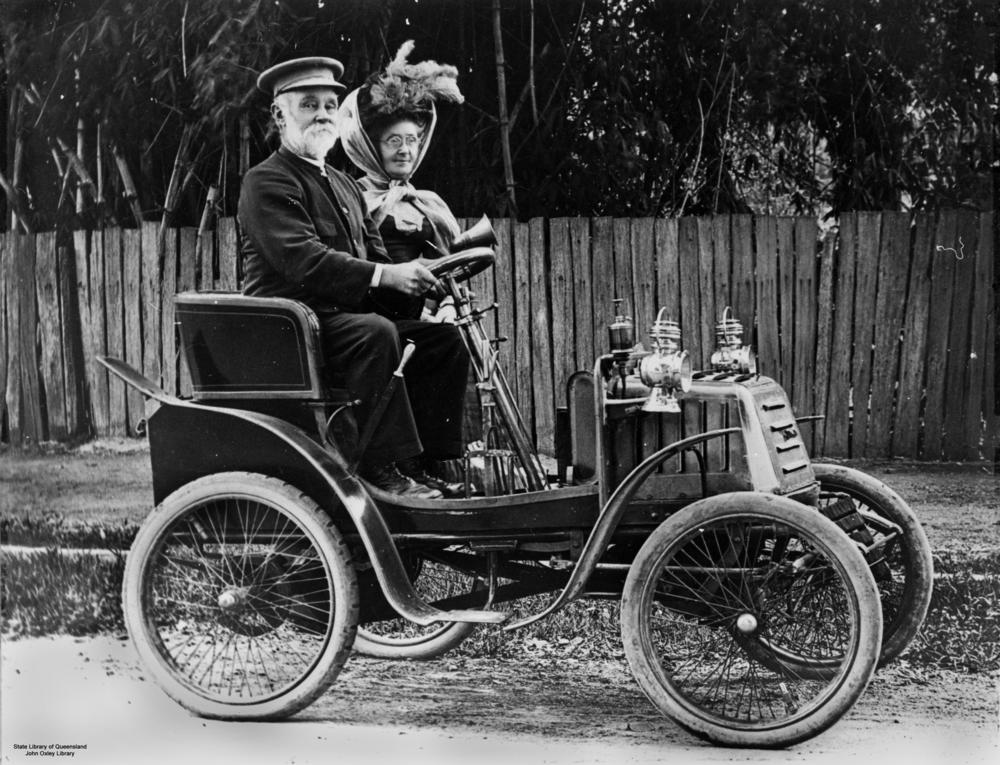 |
| Out driving in an early Linon motor car in Ipswich, QLD, about 1902 |
 |
| Aboriginal people swimming at Deebing Creek, QLD, Sydney Mail and New South Wales Advertiser (NSW : 1871 - 1912), Wednesday 2 December 1903 |
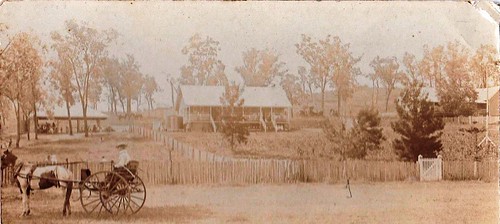 |
House in Ipswich, Queensland - circa 1907 Written on back: "This is where Jim Lister lives in Ipswich"
I found James Lister on several census returns from 1903 to 1913 in the Herbert region. He was a miner at Mount Garnet, Chillagoe and Collgarra. Kaye |
 |
| Nicholas Street, Ipswich, Qld - circa 1908, Aussie~mobs |
 |
| Looking towards Denmark Hill in Ipswich, Qld - circa 1908, Aussie~mobs |
 |
Wilson family and friends at "Claremont" in Ipswich, Queensland - 1910. Aussie~mobs L - R: Mary Norma Wilson, John Cecil Norman Wilson, Harriett Louisa Wilson, Cecil Murray Wilson, Enid Maud Murray Wilson, Charles Morris (Police Magistrate of Ipswich) and Harriet Meta Murray Wilson and Bussy the dog. The two boys were students from Ipswich Grammar School. |
 |
| Cricket match at Deebing Creek Aboriginal Reserve, Ipswich, QLD - 1910 |
 |
| Brisbane Street, Ipswich looking west - 1910, Kaye |
 |
| Cribb & Foote, a department store in Ipswich, Queensland, existed from 1849 until 1985, Queensland Times (Ipswich, Qld. : 1909 - 1954), Tuesday 23 December 1913 |
 |
| "Cornubia", an early Ipswich residence, QLD, ca. 1914 was at 13 Murphy Street, Ipswich and was the home of William Hancock, who built the residence about 1880. |
 |
| Dr. Eleanor Constance Greenham, first Queensland born woman to take a degree in medicine, ca. 1915, State Library of Queensland |
WWI
 |
| CPL R. J. CAREW, D.C.M. Word has just been received (writes a correspondent) that the Distinguished Conduct Medal has been awarded to an Ipswich lad. Cpl R. J. Carew, Queensland Times (Ipswich, Qld. : 1909 - 1954), Saturday 7 October 1916 |
 |
Major Percival Savage, DSO, 3rd Field Company, AIF, 1916. Percival Savage was was a World War I veteran who served as an ANZAC in Gallipoli, the Somme, Pozières, Passchendaele and Amiens. He was born in Ipswich, Queensland, Australia, on 22 October 1894.After the war, Savage farmed a property near Brisbane and he was chairman of the board of the Committee of Direction of Fruit Marketing in Queensland for 30 years. In1964, Savage was involved in the establishment of the Golden Circle cannery.
|
 |
Goodna Hospital for the Insane, Queensland, 1919 Hospital for the Insane was establishment at Goodna in 1865 on an isolated site between Brisbane and Ipswich. The facility is now known as Wolston Park Hospital, and originally known as Woogaroo Asylum. The original terrain was heavily wooded but then cleared as shown in this photograph, ca. 1919. SLQ
|
Electric Light Company, Limited, to supply electricity within the city of Ipswich and the shire of Ipswich 1919.
1920s
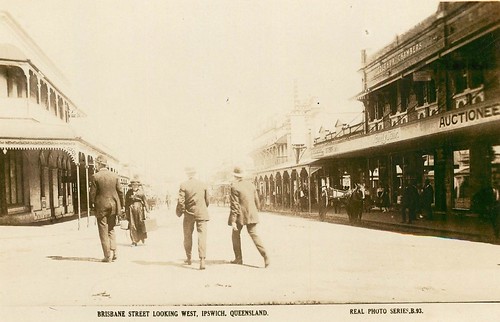 |
| Brisbane Street, Ipswich, QLD, Australia - circa 1920. Kaye |
 |
| Ipswich Past Brothers Rugby League Club, QLD, 1922, State Library of Queensland |
 |
| Crossley cars used for the 1927 Royal Visit refuelling in Ipswich, Queensland, State Library of Queensland |
 |
| Queensland Woollen Manufacturing Co Mill, Ipswich, c 1927, Queensland State Archives |
1930s  |
| Brisbane Street, looking west, Ipswich, Qld - 1930s perhaps. Aussie~mobs |
 |
| Nicholas Street, Ipswich, Qld - 1930s, Aussie~mobs |
 |
| Brisbane Street in Ipswich, Qld - 1930s, Aussie~mobs |
 |
| Former Trades Hall, Ipswich, QLD, Queensland Times (Ipswich, Qld. : 1909 - 1954), Wednesday 4 July 1934 |
 |
| Brynhyfryd (which is Welsh for 'pleasant hill') was was one of the most imposing buildings in Ipswich and built in 1891, a mansion for coal mining magnate Lewis Thomas Courier-Mail (Brisbane, Qld. : 1933 - 1954), Wednesday 24 February 1937 |
 |
| Ipswich Ambulance Cars, QLD, Telegraph (Brisbane, Qld. : 1872 - 1947), Tuesday 28 September 1937 |
An army camp was set up at Redbank in 1939.
1940s and WWII
Various air raid shelters
were built around Ipswich during WWII. Some were built behind the railway workshops and trenches were dug in parks and schools.
RAAF Base Amberley commenced operations in 1940.
 |
| Telegraph (Brisbane, Qld. : 1872 - 1947), Thursday 29 February 1940 |
 |
| The special recruiting train which will start a tour of Queensland for the Royal Australian Air Force next week at Ipswich yesterday. The special recruiting train which will start a tour of Queensland for the Royal Australian Air Force next week at Ipswich yesterday. Courier-Mail (Brisbane, Qld. : 1933 - 1954), Saturday 3 August 1940 |
 |
| Telegraph (Brisbane, Qld. : 1872 - 1947), Monday 26 August 1940 |
 |
| Ipswich Workshops, QLD, The largest machine tool made in Australia until 1943 was made at Ipswich Workshops during WW 2. The 36” lathe is being tested in the Erecting Shop before being crated and dispatched, Queensland State Archives |
 |
Cpl. Pat Kendall, Ipswich, is ready for action with the waist gun of a R.A.A.F. Liberator bomber.
Pilot of the bomber instructs the W.A.A.F. when to load guns, when to fire and when to cease. Tests usually occupy two hours, and W.A.A.F's do complete job, relieving R.A.A.F. ground staff fortheir duties. Courier-Mail (Brisbane, Qld. : 1933 - 1954), Wednesday 4 October 1944 |
By 1947 the railways workshops in North Ipswich
employed almost 3000 people.
 |
| Main entrance, Queens Park, Ipswich, circa 1940s |
 |
| Brisbane Street, Ipswich, QLD. with QCWA Hostel in foreground, 1940s? |
 |
| Brisbane Street, Ipswich, QLD, Brisbane Telegraph (Qld. : 1948 - 1954), Wednesday 6 April 1949 |
 |
| There are four railway stations in Ipswich named "Ipswich"—"Old Ipswich," "New Ipswich," "East Ipswich," and "Little Ipswich." This is Little Ipswich railway station on the Boonah line and about a mile from the Ipswich Post Office. Historically it is of great interest but practically it is not what is called a busy station. Queensland Times (Ipswich, Qld. : 1909 - 1954), Tuesday 4 October 1949 |
1950s
 |
| Harold Blair AM (13 September 1924 – 21 May 1976) was an Australian Aborignal tenor who was born at the Cherbourg Aboriginal Reserve and raised in Ipswich, QLD, Courier-Mail (Brisbane, Qld. : 1933 - 1954), Friday 4 May 1951 |
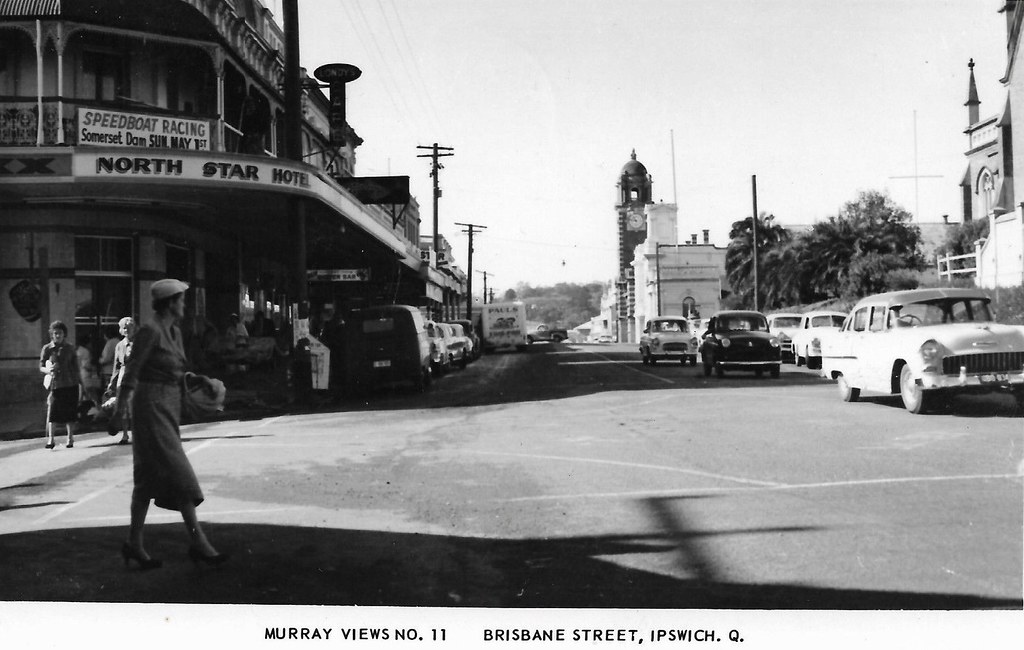 |
| Brisbane Street, Ipswich, QLD - circa 1950s. Aussie~mobs |
 |
Mr Stewart, who topped the batting averages one year stated yesterday that crowds flocked to the Din-more ground in hundreds whenever the aboriginal team from Deebing Creek played the local side. He said they were really spectacular and fine cricketers, and always amused the spectators by performing cartwheels and somersaults when a wicket was captured. Among the cricketers Mr. Stewart played against was Henry, the great aboriginal fast bowler, who is credited with having broken stumps with his fastest balls. Other members of that team were Curtis and Billy Brown. "And couldn't they bowl!"
added Mr. Stewart with a grin. Queensland Times (Ipswich, Qld. : 1909 - 1954), Tuesday 7 July 1953 |
 |
| Maternal and Child Welfare - Ipswich, circa 1955, Queensland State Archives |
 |
| Main street of Ipswich taken from Limestone Hill, November 1957, Queensland State Archives |
1960s
 |
| Ipswich Central Girls and Infants State School, taken circa 1960, Queensland State Archives |
 |
| Brisbane Street, Ipswich, April 1965, Queensland State Archives |
1970sThe Box Flat mine disaster occurred on 31st of July in 1972; 17 men died, eight of whom were part of the Rescue Team.
1980s
Reid’s Department Store (formerly Cribb and Foote) was destroyed by fire in 1985.
Notable
The Thorn FamilyIn 1829, the first brick house was built at Limestone, on the east side of what is now Thorn Street. Thorn Street being named after the Thorn family, who were very early pioneers and the first free settlers of the district, arriving in 1839.
George Thorn, who
arrived at Ipswich in July 1839 with his family, was the original superintendent of convicts at Limestone Hill, later a politician.
George Thorn and his wife Jane, with their infant son, George Jnr, were rowed in a flat-bottomed boat up the Bremer River to their new home at Limestone Hill. Four of George and Jane's six sons went on to serve in the Queensland Parliament, following their father who served in the first Legislative Assembly of Queensland. (
see here)
Later, the family operated the Queen's Arms Hotel in Ipswich in 1847.
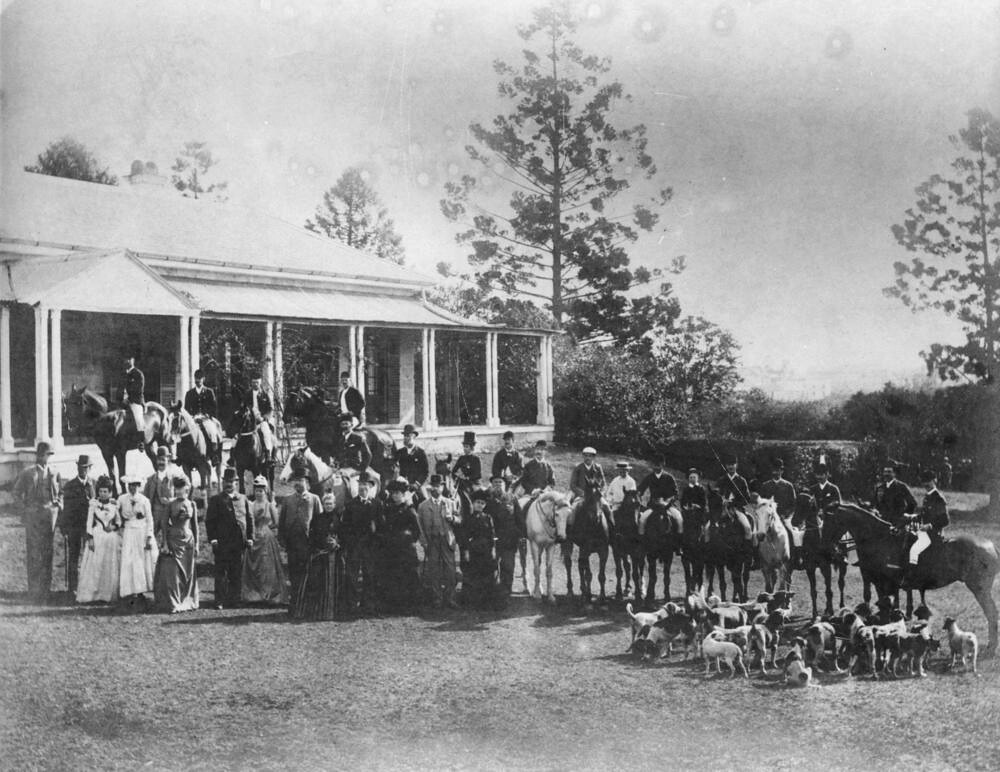 |
| The Hunt at "Claremont" Ipswich, Queensland, circa 1890. Aussie~mobs. Claremont was purchased by George Thorn (senior), in 1862. Claremont, built by Alfred Lewis in 1856 for John Panton, is the oldest house in Ipswich, Queensland, Australia. |
 |
Bessie Gibson (Australian painter) 1868 - 1961 Luxembourg Gardens, s.d. (double sided)
oil on wood panel, about 1905 |
Elizabeth Dickson (Bessie) Gibson (1868-1961) was born in 1868 at Ipswich, Queensland. She was the daughter of James Gibson, a bank manager, and his wife Anne. Bessie studied at Brisbane's Central Technical College under Godfrey Rivers, who made the suggestion that she submit a miniature of her father to the Royal Academy in London in 1905. That same year, she also travelled to London, and in 1906, she was living in the Montparnasse area of Paris, where she exhibited her paintings frequently in various salons. She lived in Paris and England until 1939, just before the German occupation. She returned to Australia in 1947.
Around Ipswich
 |
| Plantation-style mansion which was built in 1890 at Seminary Road, Marburg, City of Ipswich, Queensland |
.jpg) |
| Queensland Country Women's Association Girls' Hostel, Ipswich |
 |
| Ulster Hotel is a heritage-listed hotel at 25 Brisbane Street, Ipswich, City of Ipswich, Queensland, Australia. It was built in 1910. 2011 floods. GA. |
 |
| Queensland National Bank at Ipswich, Queensland, Australia. Built from 1877–1935 |
 |
| William Johnston's Shops, Ipswich, were built from 1877 to 1880s. |
 |
| Old Ipswich Town Hall was built from 1861 to 1879. |
 |
| Bostock Chambers office building at Ipswich, Queensland, Australia, built in 1915. |
 |
| The Flour Mill was built in 1901-1902 for the Ipswich Milling Company Ltd. |
 |
| Hotel Metropole, West Ipswich, Queensland, Australia, built in 1906. |
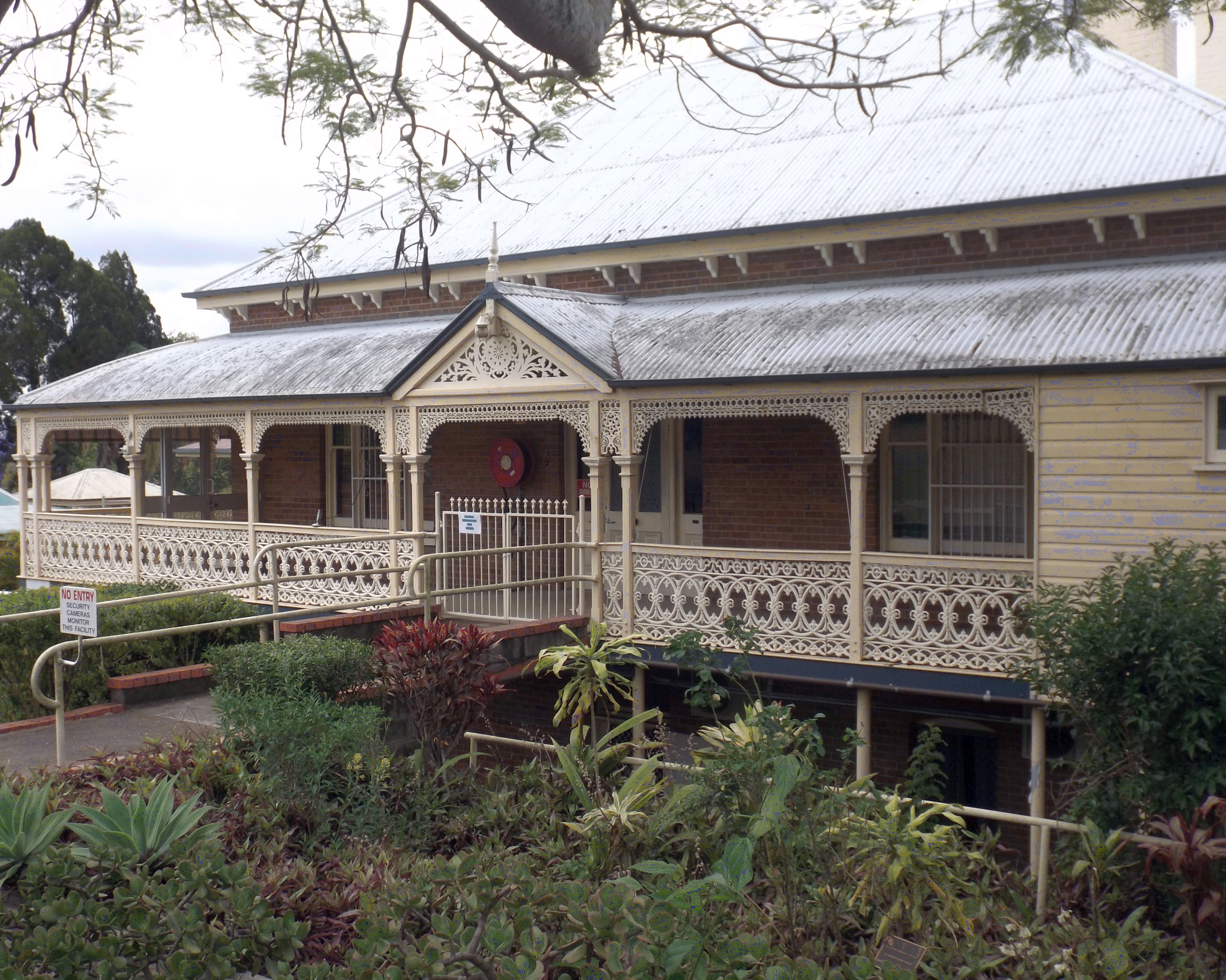 |
| St Michaels Nursing Home, Ipswich, QLD, was built in 1874. |
.jpg) |
| Ipswich Girls' Grammar School Buildings, built from 891 to 1968. |
 |
| St Paul's Young Men's Club, Ipswich, QLD, was built in 1911. |
 |
| Toronto is a two-storey timber residence, at Ipswich, erected in 1863 for Mrs Elizabeth Lloyd. |
 |
| Keiraville built in the 1880s and bought soon afterwards by the Cribb family. Ipswich, QLD. |
 |
| Gooloowan residence from Outridge Street, Ipswich, Queensland, built for Benjamin Cribb and family. Built from c. 1864 onwards . |
 |
| Ozanam House, Ipswich, was built from c. 1886 to 1930s |
 |
| North Ipswich Pharmacy, Ipswich QLD, drewish |
 |
| Baptist Church is a heritage-listed former church, built in 1877, Ipswich, QLD flagondry |
.jpg) |
| Hotel Cecil is a heritage-listed hotel at 15 Lowry Street, North Ipswich, QLD, opened in 1880 |
 |
| Photo of Ipswich & West Moreton Building Society at Ipswich, Queensland, built from 1888 to 1950s |
 |
| Photo of the front of the Ipswich Club House and its gardens in Ipswich, QLD, built from c. 1915 to 1916 |
 |
| Brickstone, Murphy Street, Ipswich, Qld. Built c. 1864 by William Hancock. It is also known as Brixton |
 |
| Keiraville, Ipswich, QLD, is a single storeyed rendered masonry house, the first stage of which was probably erected c. 1880s |
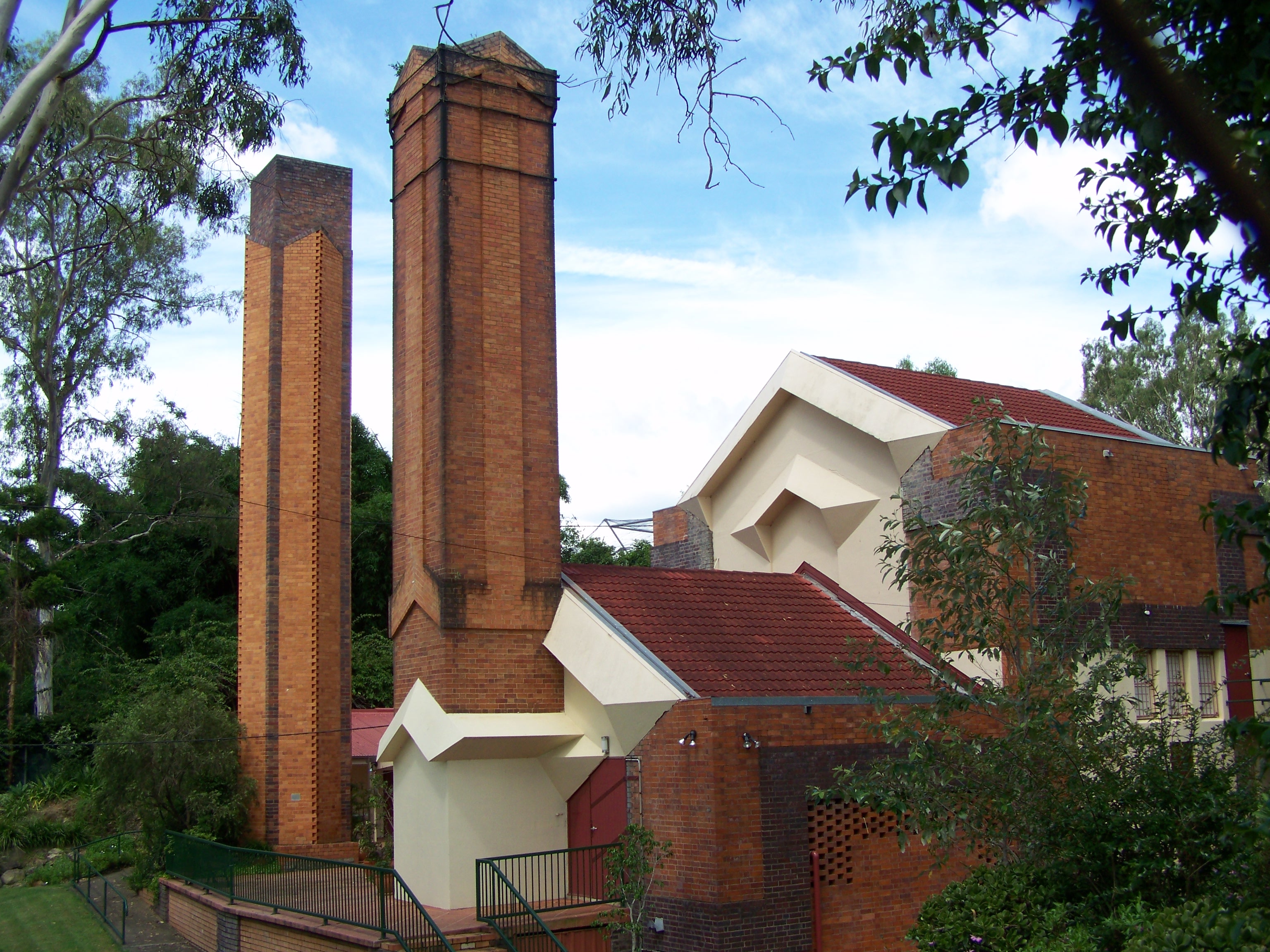 |
| Walter Burley Griffin Incinerator built from 1936 to 1940 |
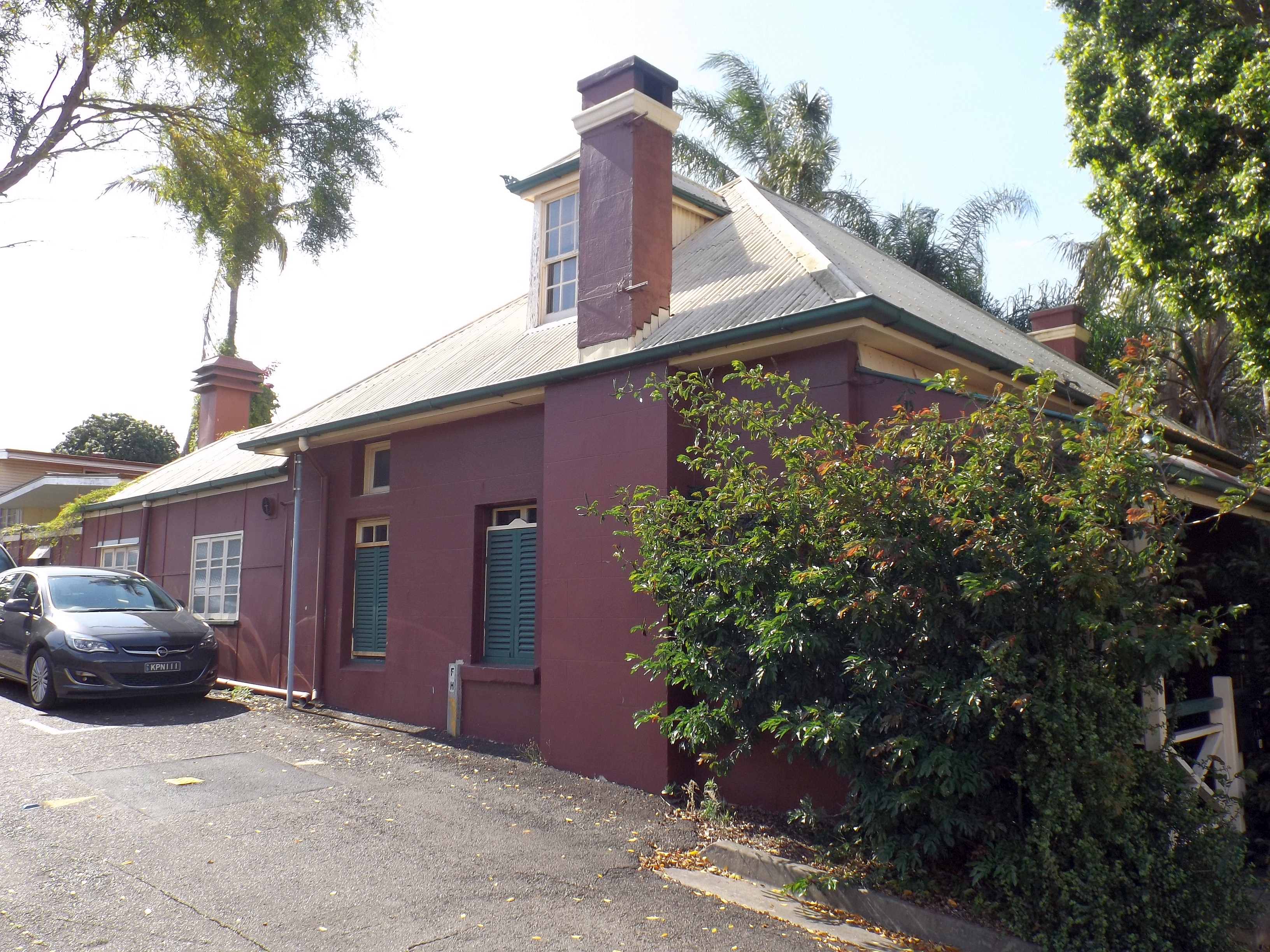 |
| Ginn Cottage , Ipswich, QLD, built in 1859 for William Ginn and his second wife Eliza Jane |
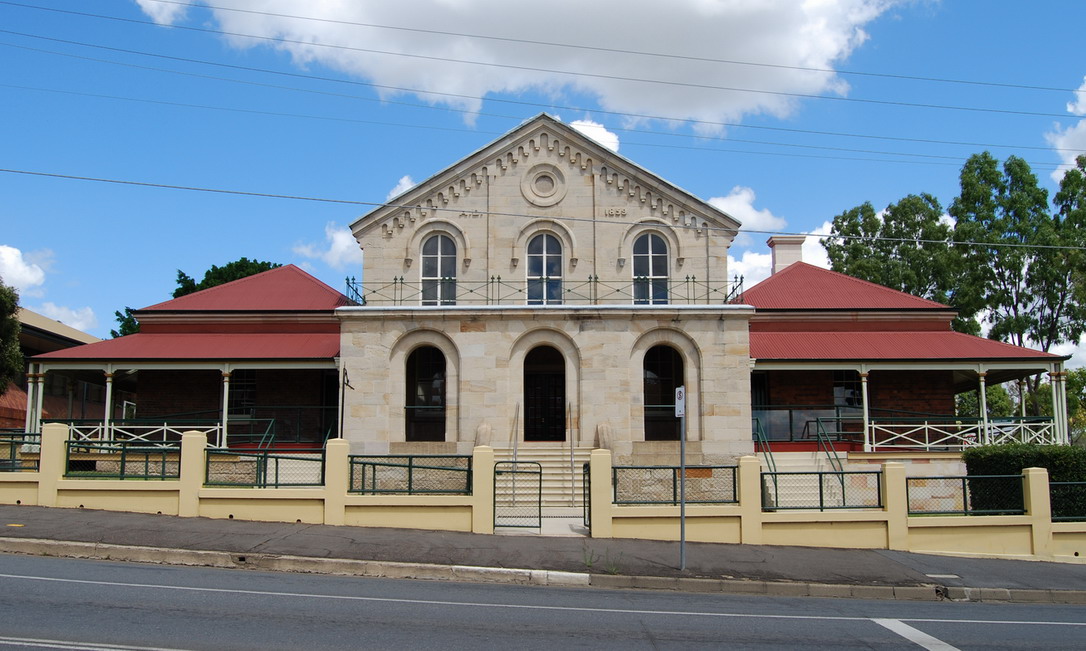 |
| The Old Ipswich Courthouse, QLD, built from 1859 to 1936 |
 |
| To-Me-Ree is a heritage-listed detached house at 7 Macalister Street, Ipswich, QLD, built c. 1910 |
Things To Do and Places To Go






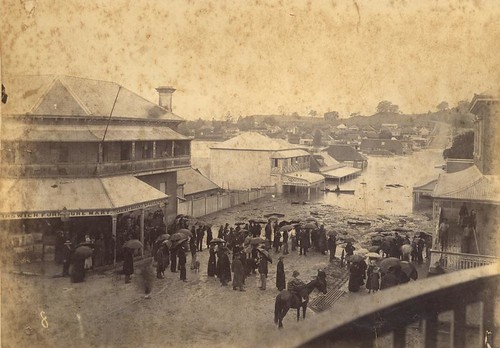








































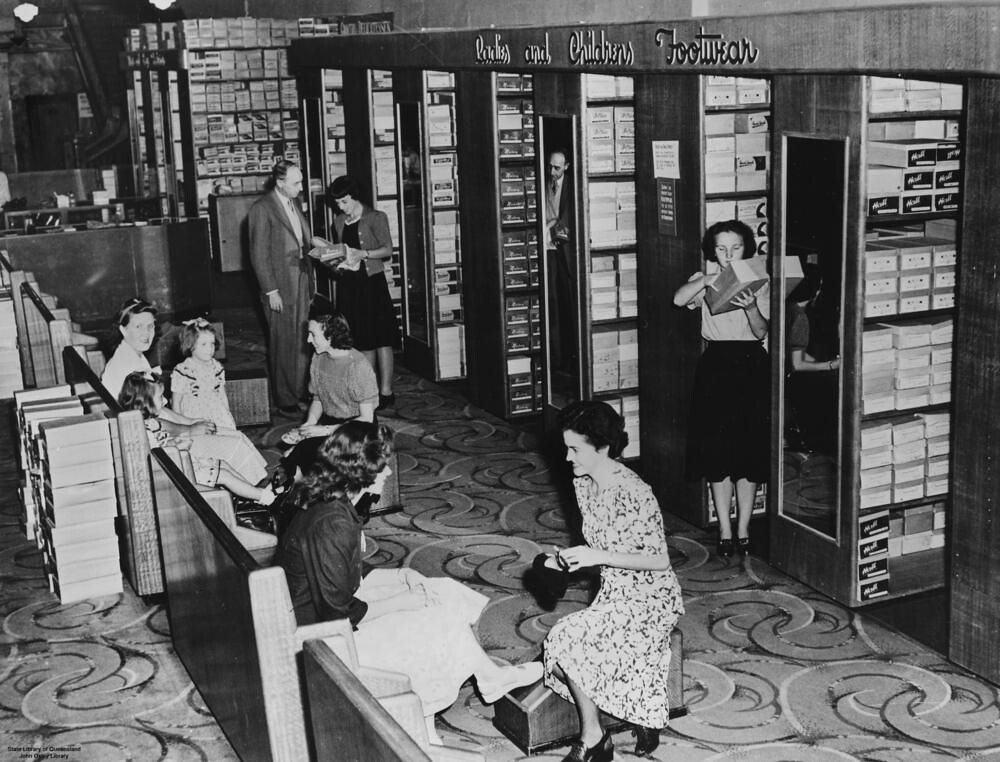











.jpg)








.jpg)







.jpg)























